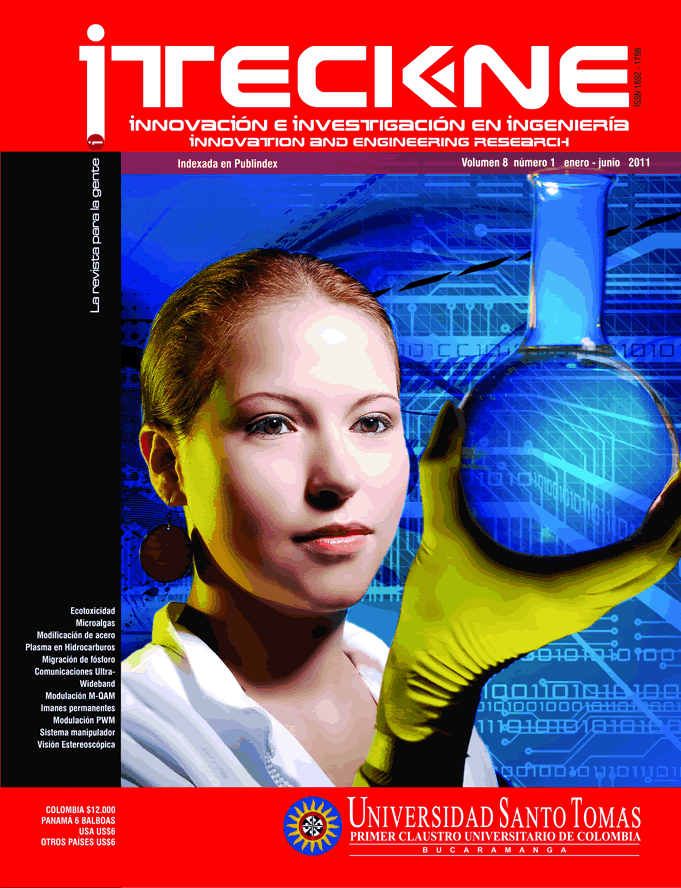Stereoscopic vision in immersive visualization systems – Practical examples
Abstract
En este artículo se ilustra el proceso de implementación de un sistema de visión estereoscópica para dos sistemas de visualización inmersiva, un casco de realidad virtual y un sistema de Caverna de Inmersión Virtual (CAVE) simplificado. Se presenta el uso de un procedimiento que comprende múltiples volúmenes de vista que se intercambian constantemente para la generación de la estereoscopía y aumentar la profundidad que se percibe de los objetos observados. La aplicación implementada permite la visualización de objetos 3D (Volúmenes básicos y modelos 3D) insertando la capacidad de estereovisión con el fin de poder extender su uso a diferentes campos como son: medicina, robótica (teleoperación), topografía (visualización de terrenos), arquitectura, mundos virtuales y educación entre otros. Adicionalmente se presentan sistemas de visualización inmersiva relacionados y las mejoras que pueden incorporarse los sistemas presentados como trabajo futuro.
Downloads
References
[2] CRUZ NEIRA, C.; SANDIN, D.; DEFANTI, T.; KENYON, R.; y HART, J.; (1992). The CAVE: SurroundScreen Projection-Based Virtual Reality: The Design and Implementation of the CAVE. En: Proceedings of the 20th annual conference on Computer graphics and interactive techniques, SIGGRAPH 1993, pp. 135 - 142.
[3] CRUZ NEIRA, C.; SANDIN, D. y DEFANTI, T.; (1993). The CAVE: Audio Visual Experience Automatic Virtual Environment. En: Communications of the ACM, Vol. 35(6), pp. 65-72.
[4] DEFANTI, Thomas A.; DAWE, Gregory; SANDIN, Daniel J.; SCHULZE, Jurgen P.; OTTO, Peter; GIRADO, Javier; KUESTER, Falko; SMARRA, Larry y RAO Ramesh; (2009). The StarCAVE, a third-generation CAVE and virtual reality OptIPortal. En: Future Generation Computer Systems, Article in press, Vol. 25(2), pp 169-178.
[5] DUBOIS, E.; (2001). A Projection Method to Generate Anaglyph Stereo Images. En: Acoustics, Speech, and Signal Processing (ICASSP ‘01) - Proceedings, Vol. 3, pp 1661 – 1664.
[6] GONZÁLEZ S., Martín; GARCÍA CORTÉS, S.; SUÁREZ QUIRÓS, J.; RUBIO GARCÍA, R.; GALLEGO SANTOS, R. y MORÁN FERNANZ, S.; (2007). Visage: Estereoscopio virtual aplicado a la geología, En: XII Congreso Internacional de Energía y Recursos Minerales.
[7] GAO, Tong; ZHENG, Xin y YIN, Qian; (2008). Software-Based Non-invasive Implementation of Binocular Vision. En: International Conference on Computer Science and Software Engineering, - 2008 , pp 1102 – 1105.
[8] HETMANN, F.; HERPERSFH, R. y HEIDENFH, W.; (2002). The Immersion Square - Immersive VR with Standard Components. En: Virtual Environment on a PC Cluster Workshop, pp 23 – 32.
[9] ISAKOVIC, Karsten; DUDZIAK, Thomas y KOCHY, Kai; (2002). X-Rooms A PC-based immersive visualization environment. En: 7th International Conference on 3D Web, Web3D 2002, pp. 173 - 177.
[10] JACOBSON, Jeffrey; (2002). Configuring Multiscreen Displays With Existing Computer Equipment. En: Human Factors and Ergonomics Society 46th Annual Meeting, Human Factors and Ergonomics Society 46th Annual Meeting. Vol. 46, pp 760-765.
[11] JACOBSON, J.; KELLEY, M.; ELLIS, S. y SEETHALLER, L; (2005). Immersive Displays for Education Using CaveUT. En: Proceedings of World Conference on Educational Multimedia, Hypermedia and Telecommunications 2005, pp 4525-4530.
[12] KUNZ, A.M. and SPAGNO, C.P.; (2001). Modified shutter glasses for projection and picture acquisition in virtual environments. En: Virtual Reality, 2001 – Proceedings, pp 281 – 282.
[13] KRUPEV, A.A. y POPOVA, A.A.; (2008). Ghosting Reduction and Estimation in Anaglyph Stereoscopic Images. En: IEEE International Symposium on Signal Processing and Information Technology, ISSPIT 2008, pp 375 – 379.
[14] MARTÍN GONZÁLEZ, S.; SUÁREZ QUIRÓS, J.; OREA AREA, R.; RUBIO GARCÍA, R.; y GALLEGO SANTOS, R.; (2005). Creación de una librería utilizando Open GL para el desarrollo de aplicaciones gráficas utilizando sistemas de visión estereoscópica. En: Memorias XVII Congreso Internacional de Ingeniería Gráfica.
[15] N. R. C. Staff; ANNE S., M.; y NATHANIEL I., D.; (1994). Virtual Reality: Scientific and Technological Challenges. Washington, National Academies Press, 111 - 133.
[16] PAIR, J.; JENSEN, C.; FLORES, J.; WILSON, J.; HODGES, L. y GOTZ, D.; (2000). The NAVE Design and Implementation of a Non-Expensive Immersive Virtual Environment. En: Conference Abstracts and Applications, ACM Siggraph 2000, pp 249.
[17] PEHLIVAN, S.; AKSAY, A.; BILEN, C.; AKAR, G.B. y CIVANLAR, M.R.; (2006). End-to-End Stereoscopic Video Streaming System. En:IEEE International Conference on Multimedia and Expo – 2006, pp 2169 – 2172.
[18] QUINTERO, C., SARMIENTO, W. J. y SIERRABALLÉN E. L.; (2007). Low cost cave simplified system. En: Proceedings of Human Computer Interaction International, HCI International 2007, pp860 - 864.
[19] QUINTERO, C., SARMIENTO, W. J. y SIERRA-BALLÉN E. L.; (2008). Diseño de un prototipo de Sistema de Realidad Virtual Inmersivo Simplificado. En: Ciencia e Ingeniería Neogranadina, Vol. 18 (1), pp 35 – 50.
[20] ROLLAND, J. y HUA, H.; (2005). Head-Mounted Display Systems, Encyclopedia of Optical Engineering. New York, Marcel Dekker, 1 - 13.
[21] ROSAS, H., VARGAS, W., CERÓN, A., DOMÍNGUEZ, D., y CÁRDENAS, A.; (2006). Psychophysical approach to the measurement of depth perception in stereo vision. En: Lecture Notes in Computer Science, Vol. 4563/2007, pp. 358–366.
[22] ROSAS, H., VARGAS, W., CERÓN, A., DOMÍNGUEZ, D., y CÁRDENAS, A.; “A Mathematical Expression for Stereoscopic Depth Perception” . En: EstadosUnidos Photogrammetric Engineering & Remote Sensing ISSN: 0099-1112 ed: ASPRS v.76 fasc.3 p.301 - 306 ,2010.
[23] SILVA, L.C.; PETRAGLIA, A.; PETRAGLIA, M.R. (2003). Stereo vision system for remote monitoring and 3-D reconstruction. En: Proceedings. Seventh International Symposium on Signal Processing and Its Applications. Vol. 1, pp 9-12.
[24] SAUTER, P.M.; (2003). VR2Go A New Method for Virtual Reality Development. En: ACM SIGGRAPH Computer Graphics, Vol. 37(1), pp 19 – 24.
[25] SCHUEMIE, M.J.; VAN DER STRAATEN, P.; KRIJN, M. y VAN DER MAST, C.A.; (2001). Research on Presence in VR: a Survey. En: Cyberpsychology and Behavior Delft, Vol. 4(2), pp 183-201
[26] VOLBRACHT, S.; SHAHRBABAKI, K.; DOMIK, G. y FELS, G.; (1996). Perspective viewing, anaglyph stereo or shutter glass stereo?. En: Proceedings IEEE Symposium on Visual Languages, pp 192 – 193.
[27] YOUNGBLOOD, P.; SRIVASTAVA, S.; CURET, M.; HEINRICHS; W. L..; DEV, P.; WREN S. M. Comparison of training on two laparoscopic simulators and assessment of skills transfer to surgical performance. Journal of the American College of Surgeons: in press, 2004.



















